A preview of some of the most interesting papers appearing in the October 2008 issue of the Journal of the SID.
To obtain access to these articles on-line, please go to www.sid.org
Edited by Aris Silzars
Comparisons of motion-blur assessment strategies for newly emergent LCD and backlight driving technologies
Xiao-fan Feng (SID Member)
Hao Pan (SID Member)
Scott Daly (SID Member)
Sharp Labs of America
Abstract — Compared to the conventional cathode-ray-tube TV, the conventional liquid-crystal TV has the shortcoming of motion blur. Motion blur can be characterized by the motion-picture response-time metric (MPRT). The MPRT of a display can be measureddirectly using a commercial MPRT instrument, but it is expensive in comparison with a photo-diode that is used in temporal-response (temporal luminance transition) measurements. An alternative approach is to determine the motion blur indirectly via the temporal point-spread function (PSF), which does not need an accurate tracking mechanism as required for the direct "spatial" measurement techniques. In this paper, the measured motion blur is compared by using both the spatial-tracking-camera approach and the temporal-response approach at various backlight flashing widths. In comparison to other motion-blur studies, this work has two unique advantages: (1) both spatial and temporal information was measured simultaneously and (2) several temporal apertures of the display were used to represent different temporal PSFs. This study shows that the temporal method is an attractive alternative for the MPRT instrument to characterize the LCD's temporal performance.
Figure 2 shows a typical captured sequence of a moving edge that crosses the middle of a 37-in. LCD screen. The simulated retinal image is the superposition of the shifted version of the captured frames due to smooth pursuit eye tracking. When the frame period of the capture camera is much smaller than that of the LCD, the integration of the captured sequence in the motion trajectory is equivalent to the measured edge of the MPRT tracking camera system.

FIGURE 2 — Captured sequence of a moving edge (10 camera captures per one LCD frame).
Motion-blur evaluation: A comparison of approaches
Michael E. Becker (SID Member)
Display-Metrology & Systems
Abstract — In this paper, the results obtained from two independent evaluations of motion-blur effects with respect to the agreement between the two different approaches used, imaging and non-imaging, are analyzed. The measurements have been carried out in different laboratories by different operators without the prior intention of a subsequent analysis as presented here. The resulting data is analyzed to quantify the repeatability of each instrument and, in a second step, the comparability of results from the two approaches is investigated. The imaging approach used in these experiments is based on a stationary high-speed camera with temporal oversampling and numerical image-data processing to obtain the intensity distribution on the retina of an observer under the condition of smooth pursuit eye tracking. Results from that approach are compared to results obtained from the evaluation of step responses acquired with optical transient recorders by frame-period convolution. Measurements are carried out with a first LCD monitor with test patterns of both contrast polarities, with three velocities of translation and four levels of gray. A second object of measurement is used for investigation of the effect of operator intervention in the process of evaluation of the imaging approach, especially on the determination of the reference levels that are needed for evaluation of the normalized blurred edge (NBE). Possible sources of uncertainties are identified for all approaches and instruments. Based on the analysis of that data, the practicability of step-response-based evaluations of the "blurred edge width/time" compared to the results obtained using the high-speed imaging approach, as long as there is no motion-dependent image processing, are confirmed.
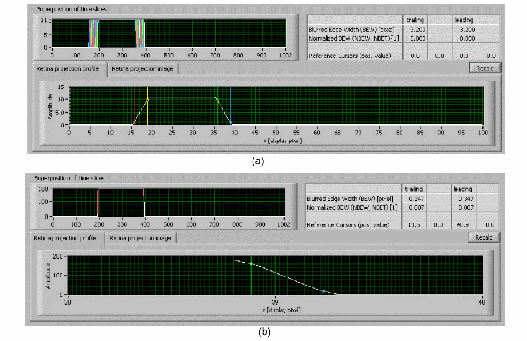
FIGURE 12 — (a) Evaluation of edge blur of a synthetic block target moving on an ideal hold-type display (i.e., zero transition time) yielding a NBE of 0.800. (b) Evaluation of edge blur of a synthetic block target on an ideal hold-type display with blanking (10% ON duty ratio, pulse of 2-msec width at 50-Hz frame frequency) yielding an NBE of 0.087. The leading edge is magnified for illustration purposes.
LCD models to analyze and simulate motion artifacts
Carsten Dolar
Dortmund University of Technology
Abstract — In this paper, two models to evaluate the temporal behavior of liquid-crystal displays are described: a model assuming a linear display behavior and a model that incorporates non-linear effects. For the linear temporal model, it can be predicted that the response time starts to contribute to motion blur when it is longer than one-sixth of the hold time and becomes dominant when it is longer than eight times the hold time. The non-linear model can be used to visualize the appearance of effects that cannot be determined via linear system theory. Also, some means to reduce display artifacts are described and its impact is illustrated. Although the main focus in this article is on the temporal behavior of liquid-crystal displays, the spatial properties defined by the pixel structure can be simulated as well. A formula for the spatio-temporal display behavior is given, which can be evaluated numerically to simulate the perceived image for arbitrary image-sequence input material.
There are two types of models for the LCD behavior described in the literature: A model with linear temporal behavior [Fig. 1(a)] and with non-linear temporal behavior [Fig. 1(b)]. Both models will be used to describe and analyze LCD behavior, but the implemented simulation tool uses the more-general LCD model with non-linear temporal behavior because the linear behavior is also covered by it when choosing the same response time for every gray-level step.

FIGURE 1 — Models for the simulation of the LCD behavior: (a) Model with linear temporal behavior, (b) model with non-linear temporal behavior.
Characterizing displays by their temporal aperture: A theoretical framework
F. H. van Heesch (SID Member)
M. A. Klompenhouwer (SID Member)
G. de Haan
Abstract — The spatio-temporal aperture and sample rate of a video display determines both the static and dynamic resolution of the video signal that is rendered. The dynamic display characteristics like the visibility of large-area flicker, motion judder, and motion blur can be derived from the frame rate and the temporal extent of the pixel aperture (i.e., the temporal aperture). For example, liquid-crystal displays (LCDs) have an aperture that is relatively small in the spatial dimension and wide in the temporal domain. Consequently, moving objects displayed on an LCD suffer from motion blur. Especially in TV applications, the temporal dimension has a large impact on the overall picture quality. The temporal aperture, together with the frame rate, is shown to predict the amount of perceived large-area flicker, motion judder, and motion blur and also the performance of motion-blur reduction algorithms for LCDs. From this analysis it is further determined how to obtain the optimal temporal aperture of a television display, for which not only properties of the human visual system (HVS), but also the properties of the video signal have to be taken into account.
The temporal aperture is the response of the HVS to spatio-temporal frequencies, i.e., the modulation transfer function (MTF) of the HVS. Although, in practice, this is a non-linear function that among others depends on the intensity, it is sufficient for our analysis to approximate it by a spatio-temporal perception window by only considering its approximate limits.
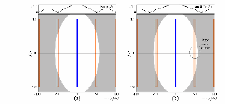
FIGURE 3 — The spatio-temporal frequency plots of the perceived video signal (without motion) (a) on a hold-type display and (b) on a stroboscopic display. Spatial frequencies are plotted vertically, temporal frequencies are plotted horizontally. The sampling of the video signal results in repeat spectra at multiples of the sample rate (50 Hz). The gray-area depicts the spatio-temporal frequency bound of the HVS. The plot shows the influence of the temporal display aperture on the suppression of the signal repeats; (a) full suppression on a hold-type display, (b) large-area flicker at 50 Hz on a stroboscopic display with α = 0.75.
A geometrical approach for inverting display color-characterization models
Jean-Baptiste Thomas
Philippe Colantoni
Jon Y. Hardeberg
Irène Foucherot
Pierre Gouton
Gjovik University College
Abstract — Some display color-characterization models are not easily inverted. This work proposes ways to build geometrical inverse models given any forward color-characterization model. The main contribution is to propose and analyze several methods to optimize the 3-D geometrical structure of an inverse color-characterization model directly based on the forward model. Both the amount of data and their distribution in color space is especially focused on. Several optimization criteria, related either to an evaluation data set or to the geometrical structure itself, are considered. A practical case with several display devices, combining the different methods proposed in the article, are considered and analyzed.
The main idea of the method and the notation we used are the following: One can define a regular 3-D grid in the destination color space (RGB). This grid defines cubic voxels. Each one can be split into five tetrahedra. This tetrahedral shape is preserved within the transform to the source space (either CIEXYZ or CIELAB). Thus, the model can be generalized to the entire space, using tetrahedral interpolation. The generalized way to define such a grid is to take directly a linear distribution of points on each digital R, G, and B axis as seeds and to fill up the rest of the destination space (Fig. 1).
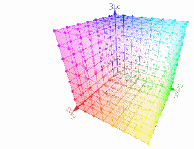
FIGURE 1 — Design of a regular grid Nrgb = 24 in RGB.
3-D crosstalk and luminance uniformity from angular luminance profiles of multiview autostereoscopic3-D displays
Marja Salmimaa (SID Member)
Toni Järvenpää (SID Member)
Nokia Research Center
Abstract — Autostereoscopic 3-D display technologies enable a more immersive media experience by adding real depth to the visual content. However, the method used for the creation of a sensation of depth or stereo illusion contains several display design and content-related issues that need to be carefully considered to maintain sufficient image quality. Conventionally, methods used for 3-D image-quality evaluations have been based on subjective testing. Optical measurements, in addition to subjective testing, can be used as an efficient tool for 3-D display characterization. Objective characterization methods for autostereoscopic displays have been developed. How parameters affecting stereo image quality can be defined and measured and how their effect on the stereo image quality can be evaluated have been investigated. Developed characterization methods are based on empirically gathered data. In this paper, previously presented methodology for two-view displays is extended to cover autostereoscopic multiview displays. A distinction between displays where the change in content occurs in clear steps when the user moves in front of the display, and displays where the apparent movement of the objects is more continuous as a function of the head movement is made. Definitions for 3-D luminance and luminance uniformity, which are equally important, as well as 3-D crosstalk, which is the dominant factor in the evaluations of the perceived 3-D image quality, is focused upon.
One of the main drivers for multiview displays is that they may enlarge the effective viewing freedom of 3-D displays and provide a "look around" objects effect compared to two-view displays. In principle, this can be realized with both barrier- and lenticular-type displays, the latter better maintaining the 2-D luminance level of the display. To be able to utilize larger viewing freedom or "look around," the user typically needs to move in front of the display, or to rotate the display in the case of a hand-held device.
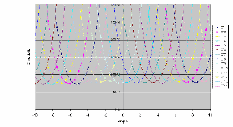
FIGURE 6 — Calculated 3-D crosstalk in multiview 3-D display mimicking continuous motion parallax.
The effects of glossy screens on the acceptance of flat-panel displays
Kjell Brunnström (SID Member)
Katarina Josefsson
Börje Andrén (SID Member)
Abstract — The TCO requirements provide well-known and recognized quality labels for displays. For these requirements to remain useful, they must continuously be reviewed and updated when necessary. The study described here was performed in response to the market trend of designing flat-panel displays and notebooks with glare panels. The purpose of this study was to investigate subjective responses to display screens of different gloss levels for office workers working on different tasks under normal office-lighting conditions. The study consisted of three parts, one where the users should set an acceptable reflex level, one where the user should rate their disturbance on a category scale, and one where the visual acuity of the users were investigated whether they were affected by glare or not. The results show that increasing gloss and increasing luminance levels had negative effects on the acceptance and the disturbance of reflexes. There were statistically significant differences in the acceptance and the disturbance levels between screens with low gloss and screens with high gloss, which suggests that screens with the highest gloss levels should be avoided. The study did not show an effect on the performance based on acuity testing.
A light-emitting-diode (LED) lamp with 36 white diodes was used to create the reflex on the screen. The luminance of the lamp was measured to 85,000 cd/m2 at 240 V. To obtain a structure in the reflex on the screen, a lens was placed in front of the lamp to collimate the light rays. This made each diode visible on the screen. Also, a crossbar made of black tape was put on the lamp to make the visible reflex more structured (like a reflection from a window with window bars).
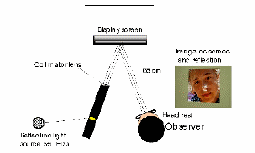
FIGURE 2 — The test set up. The angle in which the light falls on the screen is 20°, as well as the angle in which the observer is looking.
Surface treatment, reflectance, and age effects on electronic-paper reading performance
Yu-Ting Lin (SID Student Member)
Po-Hung Lin
Sheue-Ling Hwang
Shie-Chang Jeng
Abstract — This study is intended to explore the legibility and visual fatigue of different age users under various surface treatments and reflectance of electronic paper. Through the method of character-search task, the results indicated that compared with single types of treatment [anti-reflection (AR) 0.8%, anti-glare, 43% haze], the compound treatment of anti-reflection and anti-glare (ARC) exhibited the same legibility, and it showed superior properties to effectively reduce visual fatigue. Hence, it is suggested that electronic-paper manufacturers should choose the compound surface treatment for better visual performance. On the other hand, the findings also validated that enhancing the reflectance of electronic paper to the same level as regular paper (about 80%) is worthy to be practically implemented. Based on the results of this study, electronic-paper manufacturers can take useful infor-mation to fulfill ergonomic requirements on product design.
Visual-fatigue measurements can be classified into psychological and physiological indexes. Employing subjective questionnaire to assess psychological visual fatigue is easy to administer and more sensitive than physiological measures. In addition, the change of critical fusion frequency (CFF) and the change of accommodation power are considered as two important physiological indexes to evaluate visual fatigue.

FIGURE 8 — Reflectance – age interaction for the change of CFF.
Analysis of the dependence of optical response time of liquid-crystal displays on the viewing direction
Hyung Ki Hong
JaeKyeong Yoon
Moojong Lim
LG Display
Abstract — The optical response time of liquid-crystal displays (LCDs) has recently been observed to be dependent on the viewing direction. For the vertically aligned LC mode, response time increased as the viewing angle increased when the final state is the zero gray level of the minimum luminance. This change in response time is analyzed to relate to the deformation of the normalized luminance curve of LCDs for different viewing directions. The dependency trends of the optical response time for the oblique direction can be estimated from the temporal luminance measurement data along the normal direction and the normalized luminance curve for oblique viewing directions.
In Fig. 3, the temporal luminance curve is observed to take longer time to reach the minimum luminance for the oblique viewing direction compared with that of the normal viewing direction. From this measurement, optical RT is calculated to be 4 msec for the normal direction and 9 msec for the viewing direction of 60°, showing a difference of more than two times. Users generally watch an LCD TV from various positions in the room. Moreover, a section of a large-area LCD is viewed from different angles even by a user in the same position. This implies that the current definition of optical RT derived from the luminance only along the normal direction may not be good enough to characterize the dynamic performance of LCDs.

FIGURE 3 — Measurement of the temporal luminance at the viewing directions of 0 and 60° for multi-domain VA-mode LCDs. The horizontal axis represents the time in milliseconds and the vertical axis represents the normalized luminance. An optical RT at 60° is measured to be larger than that at 0°.
Fast-response liquid-crystal displays using crossed fringe fields
Yan Li (SID Student Member)
Zhibing Ge (SID Member)
Ruibo Lu (SID Member)
Meizi Jiao (SID Student Member)
Shin-Tson Wu (SID Fellow)
Abstract — A fast-response and wide-view liquid-crystal display (LCD) using the crossed fringe-field-switching (CFFS) mode is proposed, where the fringe-field electrodes exist on both the top and bottom substrates. The bottom fringe field is used to turn on the LC directors and the top fringe field is used to assist in the LC decay process. The decay time is reduced by ~2x compared to that of the conventional FFS mode between the full bright and dark states, and more than a 2x improvement is obtained for other gray-scale transitions. This CFFS mode also preserves the wide-view characteristics as the conventional FFS mode. Its applications to LCD TVs and monitors for reducing image blur are addressed.
Figure 1(a) illustrates a cross-sectional view of the CFFS device structure. On both top and bottom substrates, strip pixel electrodes and planar ITO (indium tin oxide) common electrodes are formed with a SiO2 passivation layer (200 nm thick) in between. The bottom strip electrodes are perpendicular, while the top strip electrodes are at an angle α to the x axis. The LC cell has an initial homogeneous alignment and the employed LC has a negative dielectric anisotropy(Δε < 0). The bottom FFS electrodes are used to drive the LC cell to different gray levels and the top electrodes are used to accelerate the LC decay process.

FIGURE 1 — (a) Cross-sectional view of the CFFS cell.
Plasma-beam alignment technique for ferroelectric liquid crystals
Gurumurthy Hegde
Oleg Yaroshchuk (SID Member)
Ruslan Kravchuk
Anatoli Murauski
Vladimir Chigrinov (SID Fellow)
Hoi Sing Kwok (SID Fellow)
Hong Kong University of Science and Technology
Abstract — The plasma-beam alignment procedure earlier developed for the alignment of nematic liquid crystals is successfully extended to ferroelectric liquid crystals (FLC). The highly uniform alignment of the "chevron" structure (before electrical treatment of FLC cells) and "quasi bookshelf" structure (after the electrical treatment) are realized. The contrast of bistable switching larger than 350:1 is achieved. This makes the non-contact plasma-beam alignment procedure especially attractive for high-contrast bistable LCDs on an LCOS base, particularly used in PDA and e-books. Fast switching and realization of gray scale in the plasma-beam-aligned FLC cells makes this technique also promising for full-color displays including color LCD TV.
For irradiation,we used an anode layer source (ALS) with a racetrack-shaped glow-discharge area. In the beam mode, this source generates two "sheets" of accelerated plasma with a width of 25 cm [Fig. 1(a)]. The device operated in the regime of low energies (E = 500–800 eV) and currents (j = 5–20 μA/cm2). The source was set for oblique irradiation [Fig. 1(b)]. The incidence angle of the plasma beam was about 70°.
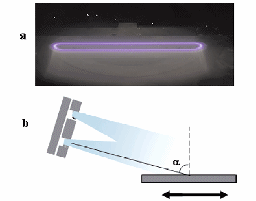
FIGURE 1 —(a) Photograph of anode layer source and generated plasma "sheets" and (b) geometry of plasma-beam irradiation of alignment substrates.